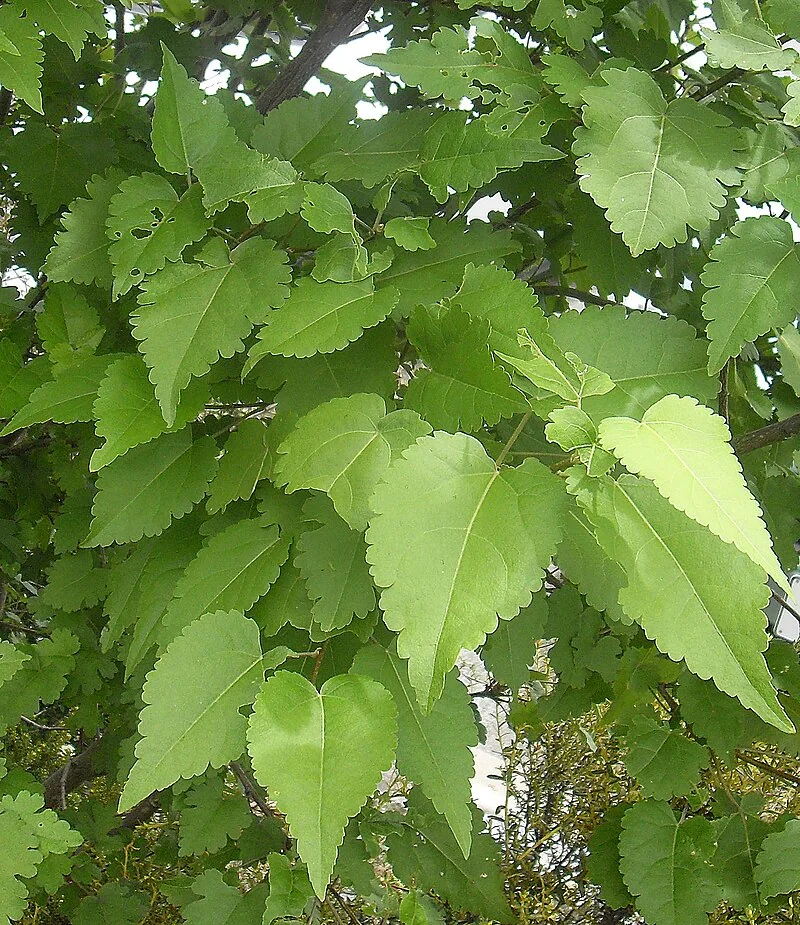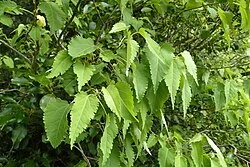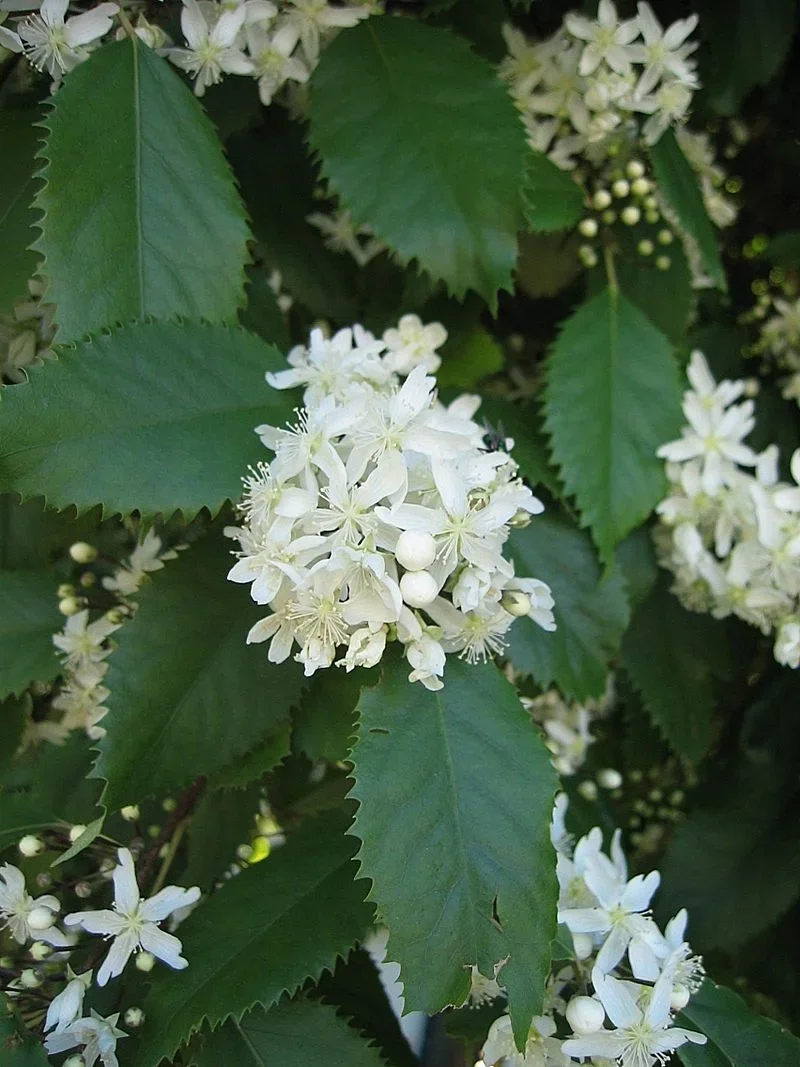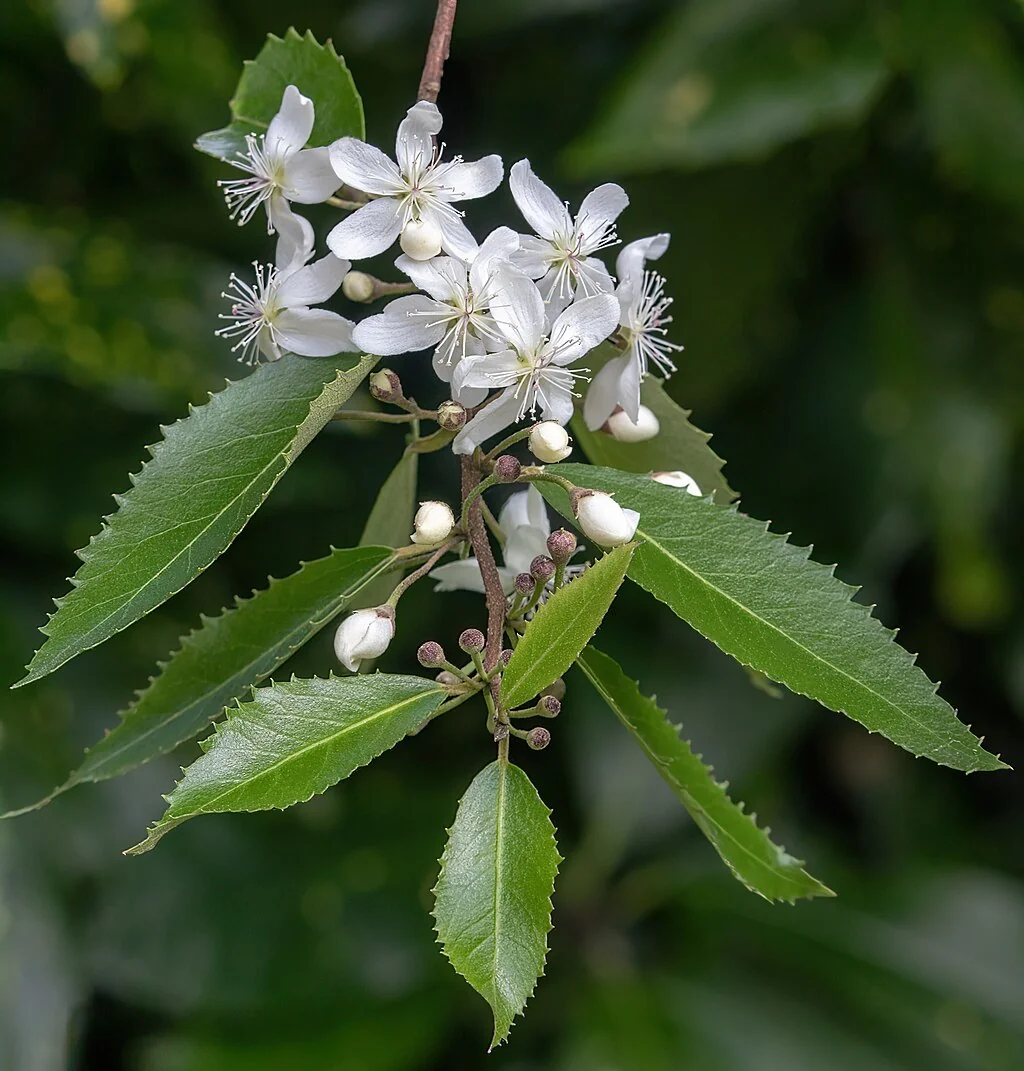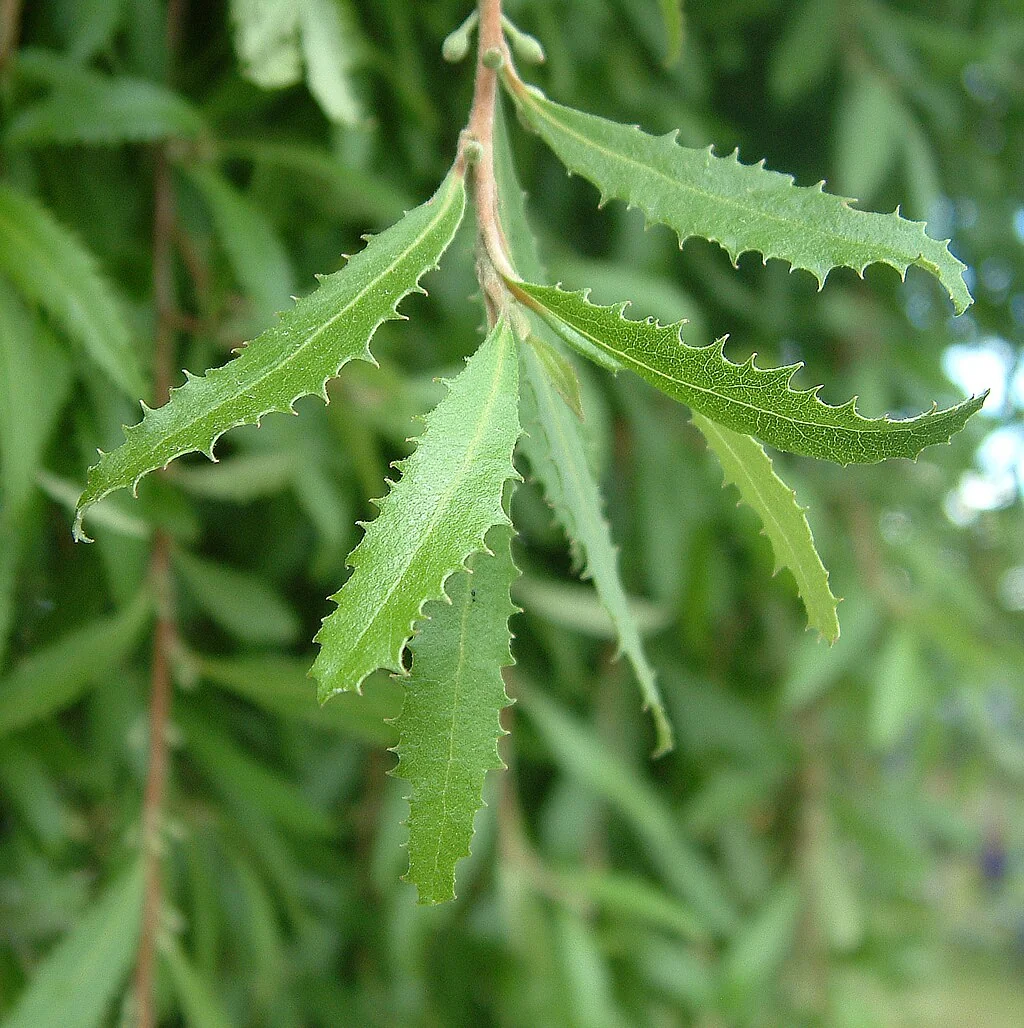
Narrow-leaved Lacebark
Hoheria angustifolia
Narrow-leaved Lacebark ( Hoheria angustifolia ) is a remarkable fast-growing evergreen native tree that showcases New Zealand's unique botanical diversity. Known to Māori as "houhi" or "houhi puruhi," this distinctive species displays fascinating heteroblastic growth, starting as a divaricate, tangled shrub before developing into an elegant tree reaching 10-18 meters tall. The species exhibits the widest natural distribution of all lacebarks, thriving mainly in lowland eastern forests from sea level to 900 metres elevation. Its narrow, serrated leaves (20-48mm long by 5-10mm wide) distinguish it from all other Hoheria species, while the persistent juvenile form with small, tangled branches makes it easily recognizable. During summer (December-February), the tree produces fragrant white star-shaped flowers that attract native pollinators, followed by distinctive papery winged fruits. This hardy culturally significant plant has traditional uses in Māori weaving and rope-making, making it an outstanding choice for restoration projects and native gardens seeking authentic New Zealand flora.

Plant Description
Hoheria angustifolia (narrow-leaved lacebark/houhere) is a graceful small tree with slender, willow-like leaves and masses of starry white flowers in late summer. Bark develops the characteristic lace-like inner layer of the genus.
Quick Facts
| Scientific Name | Hoheria Angustifolia |
|---|---|
| Common Name | Narrow-leaved lacebark, Narrow-leaved houhere |
| Plant Type | Evergreen tree or shrub |
| Height | Up to 18 m (commonly 10 m) |
| Foliage | Narrow, elongated, grey-green to dark green, coarsely toothed or serrated margins |
| Flowers | Small, star-shaped white flowers (December to February) |
| Bark | Smooth and greyish-brown when young, rougher and fissured with age |
| Fruit | Dry, papery, winged fruits |
| Habitat | Lowland forests, alluvial forests, widespread across New Zealand |
| Uses | Ornamental tree, ecological restoration, habitat for birds and insects, traditional Māori rope and twine |
| Water Needs | Moderate - adaptable to various moisture conditions |
| Light | Full sun to partial shade |
| Frost Tolerance | Hardy - tolerates moderate frosts |
| Salt Tolerance | Moderate - can handle some coastal exposure |
| Growth Rate | Fast - can reach 3-4 meters in 5 years |
| Lifespan | Long-lived evergreen tree (50+ years) |
| Spread | 4-6 m wide with narrow crown and weeping branches |
Climate Best Suited to
Narrow-leaved Lacebark thrives in temperate climate zones that provide moderate rainfall and reasonable protection from extreme weather conditions, demonstrating exceptional adaptability across New Zealand's diverse regional environments. The species exhibits robust frost tolerance once properly established, withstanding temperatures down to -10°C without significant damage to mature wood or established growth structure. Young plants benefit from frost protection during their first winter, particularly in areas that experience severe or prolonged freezing conditions. The tree performs optimally in regions with reliable annual moisture distribution, preferring areas that receive 800-1500mm of rainfall annually or equivalent irrigation supplementation during extended dry periods. While tolerant of seasonal drought once mature roots are established, consistent soil moisture during the growing season promotes vigorous growth and abundant flowering displays that make this species particularly valuable in garden settings. Narrow-leaved Lacebark appreciates shelter from severe coastal winds, particularly salt-laden storms that can damage foliage and stress the plant, though it tolerates moderate wind exposure better than many other native trees. The species adapts well to inland conditions with greater temperature extremes, provided adequate moisture is available during hot summer periods. Regional performance varies with microclimatic conditions, with trees in sheltered valleys and forest margins typically showing more vigorous growth than those in exposed sites.
Regional Suitability
| City | Climate Suitability |
|---|---|
| Whangārei | Ideal |
| Auckland | Ideal |
| Hamilton | Ideal |
| Tauranga | Ideal |
| Rotorua | Ideal |
| Gisborne | Ideal |
| New Plymouth | Ideal |
| Napier | Ideal |
| Whanganui | Ideal |
| Palmerston North | Ideal |
| Wellington | Ideal |
| Nelson | Ideal |
| Christchurch | Ideal |
| Dunedin | Ideal |
| Invercargill | Ideal |
Natural Habitat
Narrow-leaved Lacebark occupies diverse ecological niches throughout New Zealand's lowland forests, displaying remarkable habitat versatility that contributes to its widespread natural distribution and conservation security. The species naturally thrives along riparian margins where consistent soil moisture and fertile alluvial deposits create ideal growing conditions, forming an essential component of streamside vegetation communities that provide crucial habitat for native wildlife. These riverside environments offer the deep, well-drained soils and reliable water availability that support the tree's rapid growth and abundant flowering, while also providing the humid microclimates that enhance establishment success and long-term vigor. Forest edges represent another important natural habitat for this species, where the transition zone between open and closed canopy conditions creates optimal light levels for growth while providing partial protection from wind and extreme weather. River terraces throughout the South Island provide elevated, well-drained growing sites where Narrow-leaved Lacebark can establish extensive root systems in fertile, stone-free soils derived from centuries of flood-deposited sediments. The species demonstrates particular success on fertile, free-draining loam soils with good organic content, typically found in areas where natural forest succession has created deep, humus-rich growing media. Natural distribution extends from near sea level to elevations of approximately 900 meters, encompassing diverse topographical and climatic conditions that highlight the species' environmental adaptability and resilience.
Conservation Status
Current Threats and Protection
Narrow-leaved Lacebark ( Hoheria angustifolia ) maintains a conservation status of "Not Threatened" under New Zealand's threat classification system. This stable status reflects the species' widespread natural distribution and healthy population numbers across its range in lowland forests throughout New Zealand.
The species demonstrates remarkable ecological resilience and has the widest natural distribution of all lacebark species, occurring from sea level to 900 metres elevation in lowland eastern districts. This broad environmental tolerance contributes significantly to its secure conservation status, as the tree can thrive in diverse habitats from alluvial forests to drier eastern slopes.
In cultivation, Narrow-leaved Lacebark has proven highly successful and contributes to conservation through widespread use in restoration projects and native plant gardens. Its rapid growth rate, adaptability to various soil conditions, and value for native wildlife make it an excellent choice for ecological restoration initiatives, helping to preserve both the species and its associated ecosystem functions.
How to Grow
Narrow-leaved Lacebark (Hoheria angustifolia) is a hardy and fast-growing native tree that adapts well to a variety of conditions, making it an excellent choice for both urban and rural landscapes. Its unique heteroblastic growth habit and profusion of fragrant white flowers make it a rewarding plant to cultivate.
Planting Guide
Best Planting Practices
Successful establishment of Narrow-leaved Lacebark begins with careful timing and site preparation that maximizes the plant's natural vigor and rapid growth characteristics. Plant during autumn or winter months when dormancy reduces transplant shock and soil conditions typically provide consistent moisture for root establishment without the stress of supporting active top growth. Choose planting locations that accommodate the tree's mature dimensions, allowing 3-5 m. Stake in windy sites and mulch to suppress weeds.
Ecology
Narrow-leaved Lacebark plays a vital ecological role within New Zealand's lowland forest ecosystems, providing essential resources and habitat opportunities for diverse native wildlife communities throughout its natural range. The tree's prolific summer flowering creates an exceptionally valuable resource for native pollinators, including native bees, hover flies, butterflies, and other beneficial insects that depend on abundant nectar and pollen sources during the warmer months when many other native plants may be experiencing water stress or reduced flowering. The abundant white star-shaped flowers appear in dense clusters that produce copious amounts of both nectar and pollen, supporting diverse insect communities that form the foundation of healthy forest ecosystem food webs and contribute significantly to the pollination success of surrounding plant species. Beyond its outstanding value to pollinators, Narrow-leaved Lacebark provides crucial shelter and nesting opportunities for small native birds, including native finches, wrens, and silvereyes that utilize the dense juvenile foliage for protection from predators and harsh weather conditions. The tree's heteroblastic leaf development means that juvenile plants produce particularly dense, small-leaved foliage that creates excellent microhabitat conditions for invertebrates, including native moths, beetles, and spiders that contribute to the complex ecological relationships within forest communities. The extensive branching structure offers multiple nesting sites and foraging opportunities for native birds while providing corridors for movement through fragmented forest landscapes. Fallen leaves contribute to soil health through decomposition processes that release nutrients back into the forest floor system, supporting the broader plant community within the ecosystem.
Uses
Narrow-leaved Lacebark serves multiple valuable functions in contemporary New Zealand horticulture and landscape restoration, making it an exceptionally versatile choice for both private gardens and public plantings throughout the country. As a fast-growing specimen tree, it provides outstanding ornamental value through its distinctive heteroblastic foliage development, progressing from small, dense juvenile leaves to larger, broader adult foliage that creates interesting textural changes as the tree matures. The species' rapid growth rate and attractive natural form make it an excellent choice for creating quick impact in new landscapes or filling gaps in established plantings where immediate effect is desired. In shelter belt applications, Narrow-leaved Lacebark excels as a framework species that provides wind protection for more sensitive plants while contributing year-round structural interest through its evergreen nature and elegant branching patterns. The tree's prolific summer flowering displays, featuring masses of fragrant white star-shaped blooms, create spectacular seasonal focal points that rival any exotic flowering tree while providing authentic New Zealand character to garden settings. For riparian restoration projects, this species demonstrates exceptional value due to its natural affinity for streamside conditions and proven ability to stabilize soil through extensive root systems that prevent erosion and improve watershed health. The tree's tolerance of periodic flooding and ability to thrive in moist, fertile soils make it ideal for restoring degraded waterway margins and creating buffer zones that protect water quality while providing habitat for native wildlife. Conservation plantings benefit significantly from the species' proven adaptability, rapid establishment, and ecological value as both a pollinator resource and habitat provider for diverse native fauna.
Landscaping Ideas
Narrow-leaved Lacebark integrates beautifully into diverse landscape designs that emphasize authentic New Zealand lowland forest character, creating stunning plant combinations when paired with complementary native species. Plant in naturalistic groves alongside Griselinia littoralis (kāpuka) and various Pittosporum species to create layered canopy plantings that mirror the natural forest associations where these species coexist and support each other through beneficial ecological relationships. The contrasting foliage textures between Narrow-leaved Lacebark's heteroblastic leaves, Griselinia's glossy rounded foliage, and Pittosporum's varied leaf forms create dynamic visual interest throughout the seasons while providing diverse habitat opportunities for native wildlife. Native tussock grasses including Chionochloa species, Austroderia toetoe, and Carex species provide excellent textural contrast at ground level, helping to recreate the authentic grassland-forest margin environments where Narrow-leaved Lacebark naturally occurs in the wild. Consider positioning trees as specimen features in larger lawned areas where their rapid growth and distinctive heteroblastic foliage development can be fully appreciated, or use them as framework plants in mixed native borders where their evergreen structure provides year-round backbone support for seasonal flowering plants. The species works exceptionally well in riparian-themed gardens when combined with other moisture-loving natives like Cordyline australis (cabbage tree), Phormium species (flax), and various native sedges that recreate authentic streamside plant communities. For formal landscape designs, Narrow-leaved Lacebark can be pruned and shaped to create elegant screening hedges or architectural specimens, while its natural weeping growth habit makes it particularly suitable for Japanese-influenced garden styles that emphasize graceful form and seasonal flowering displays.
Seasonal Care
Winter
Winter represents the optimal season for establishing new Narrow-leaved Lacebark plantings, as dormant or slow-growing plants experience minimal transplant shock and can focus energy on root development rather than supporting active top growth. During winter months, regularly inspect tree stakes and ties to ensure they remain secure but not restrictive, adjusting ties as needed to accommodate trunk growth while maintaining adequate support against wind damage. This is also an ideal time for light formative pruning when the absence of dense foliage allows clear visibility of branch structure and growth patterns. Check mulch layers around established trees and refresh as needed to maintain consistent soil moisture and temperature moderation through the colder months. Monitor newly planted trees for signs of waterlogging or frost damage, providing additional protection if necessary during particularly harsh weather conditions.
Summer
Summer care focuses on maintaining adequate soil moisture during the warmest months when established trees are actively growing and newly planted specimens are most vulnerable to water stress. Provide supplementary irrigation during extended dry periods, particularly for trees in their first two growing seasons that have not yet developed extensive root systems. This is the peak flowering season when Narrow-leaved Lacebark produces its spectacular displays of fragrant white star-shaped blooms, making it an ideal time to appreciate the tree's ornamental value and monitor flowering performance for future garden planning decisions. Watch for signs of water stress including wilting, leaf browning, or reduced flowering intensity, adjusting irrigation schedules accordingly. Summer months also require vigilance for pest activity, including scale insects or aphids that may proliferate during warm conditions, treating promptly with appropriate organic controls if necessary.
Pruning
Pruning Techniques
Narrow-leaved Lacebark responds excellently to careful, minimal pruning that enhances its natural form while maintaining the species' characteristic rapid growth and attractive branching patterns. Focus early pruning efforts on establishing the desired tree structure, whether developing a single-stemmed specimen tree with a clear central leader or encouraging a multi-stemmed form that creates a more bushy, naturalistic appearance suitable for screening or informal plantings. During the tree's first 3-5 years, perform light formative pruning to select well-spaced main branches that will create a balanced, structurally sound framework capable of supporting the mature tree's canopy and abundant flowering displays. Remove crossing, rubbing, or competing branches that could create weak unions or interfere with the tree's natural architecture, making cuts just above outward-facing buds or lateral branches to encourage proper healing and continued growth. The species' relatively soft wood and rapid growth mean that pruning cuts heal quickly, but care should be taken to use sharp, clean tools to prevent tearing or crushing that could provide entry points for disease organisms. Perform major structural pruning during late winter or early spring when the tree is approaching active growth but before new shoots emerge, allowing the plant to respond quickly with vigorous new growth that covers pruning wounds. Once established, Narrow-leaved Lacebark requires minimal ongoing pruning beyond the removal of dead, damaged, or diseased wood and occasional light shaping to maintain desired form. Avoid heavy pruning or severe cutting back, as this can stimulate excessive water shoot growth that detracts from the tree's natural elegance and may reduce flowering performance.
How to Grow Narrow-leaved Lacebark
Narrow-leaved Lacebark is one of New Zealand's most rewarding native trees to cultivate, offering rapid growth, attractive heteroblastic foliage changes, and minimal maintenance requirements. This adaptable evergreen thrives in a wide range of conditions and provides excellent value for gardeners seeking fast-growing native species.
Growing Conditions and Site Selection
Choose a sunny to partially shaded location with good drainage and adequate space for the tree's eventual 10-18 meter height and 4-6 meter spread. Narrow-leaved Lacebark adapts well to various soil types from sandy to clay, preferring well-drained alkaline to neutral conditions. The species tolerates both wet and dry conditions once established, making it suitable for a wide range of garden situations.
Planting and Establishment
Plant in autumn or early spring when soil conditions are favorable and temperatures moderate. Dig holes twice the width of the root ball and incorporate organic matter such as compost to improve soil structure. Water thoroughly after planting and maintain consistent moisture during the first growing season to encourage strong root development and rapid establishment.
Seed Propagation
Fresh seed collected from ripe fruits provides excellent germination rates for Narrow-leaved Lacebark. Sow seeds immediately in well-draining seed-raising mix, maintaining consistent moisture and moderate temperatures. Germination typically occurs within 2-4 weeks under favorable conditions. The heteroblastic growth habit means seedlings will initially display the characteristic divaricate, small-leaved juvenile form before transitioning to adult foliage.
Cuttings
Semi-hardwood cuttings taken in late summer can root successfully with hormone treatment and controlled humidity. Take 10-15cm cuttings from healthy current season's growth, treat with rooting hormone, and place in well-draining propagation mix under consistently humid conditions with bright, indirect light.
Ongoing Care and Maintenance
Once established, Narrow-leaved Lacebark requires minimal ongoing care, making it ideal for low-maintenance landscapes. Apply balanced fertilizer in early spring to support vigorous growth and flowering. The tree's natural form requires little pruning, though light shaping can be done in late winter if desired. Monitor for scale insects and treat if necessary, though the species is generally pest and disease resistant.
Pests and Diseases
Common Problems and Solutions
Generally healthy and resilient. Passionvine hopper can excrete honeydew that leads to sooty mould-improve airflow, reduce shelter‑belt congestion, and encourage predators. Scale insects occasionally settle on older wood in dry, stressed sites; treat early and water deeply in summer droughts. Avoid prolonged waterlogging, which predisposes roots to rot in heavy soils.
Cultural Significance
Traditional Uses and Values
Known to Māori as "houhi" or more specifically "houhi puruhi" (meaning narrow-leaved houhi), Narrow-leaved Lacebark holds important cultural significance as part of New Zealand's traditional plant knowledge. The species was valued by Māori communities for its strong, flexible inner bark, which was processed into rope, twine, and occasionally textiles for practical applications.
The traditional preparation of houhi bark required specialized knowledge passed down through generations, with the fibrous inner layer carefully harvested and processed into durable cordage material. Unlike some other Hoheria species used for fine textiles, H. angustifolia was primarily valued for its strength in rope-making and utilitarian applications rather than decorative weaving.
Today, Narrow-leaved Lacebark represents an important connection between traditional Māori plant use and contemporary conservation efforts. Its widespread cultivation in restoration projects and native gardens helps preserve both the species and knowledge of its cultural applications, ensuring this valuable taonga (treasure) remains part of New Zealand's living botanical heritage while supporting ecosystem restoration initiatives.
Bonus Tip
Expert Growing Advice
For tidy structure in windy sites, lightly tip‑prune after flowering to encourage branching, and stake young trees their first year. Plant in full sun with good drainage; shelter from extreme southerlies reduces leaf tatter and extends flowering display.
